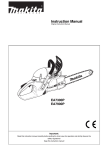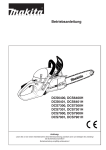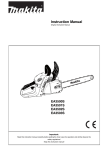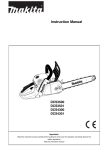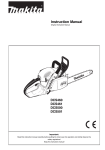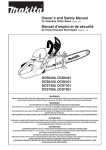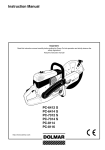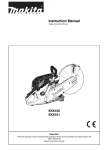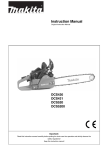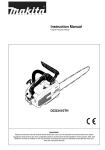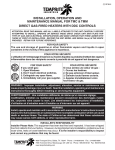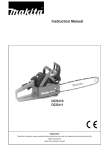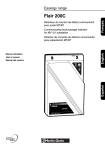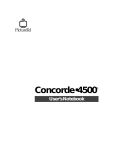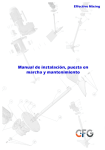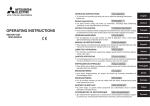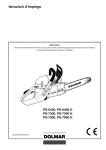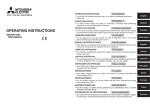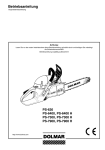Download Makita DCS7900H Instruction manual
Transcript
Instruction Manual Original Instruction Manual DCS6400, DCS6400H DCS6401, DCS6401H DCS7300, DCS7300H DCS7301, DCS7301H DCS7900, DCS7900H DCS7901, DCS7901H Important: Read this instruction manual carefully before putting the chain saw into operation and strictly observe the safety regulations! Keep this instruction manual! Thank you for purchasing a MAKITA product! Congratulations on choosing a MAKITA chain saw! We are conÞdent that you will be satisÞed with this modern piece of equipment. The DCS6400 - 7901H are very handy and robust chain saws with a new Design. The automatic chain lubrication with variable-ßow oil pump and maintenance-free electronic ignition ensure trouble-free operation, while the hand-saving anti-vibration system and ergonomic grips and controls make work easier, safer, and less tiring for the user. MAKITA chain saws DCS6400 - 7901H are equipped with the latest safety features and meet all national and international standards. These features include: hand guards on both handles, grip throttle lever lock, chain catch, safety saw chain, and chain brake. The chain brake can be actuated manually, and is also inertia-actuated automatically in case of kickback. The following industrial property rights apply: GBM 29616652, EP 0560201B1. In order to ensure the proper functioning and performance of your new chain saw, and to safeguard your own personal safety, it is imperative that you read this instruction manual thoroughly before operation. Be especially careful to observe all safety precautions! Failure to observe these precautions can lead to severe injury or death! Table of contents Page Packing ................................................................................ 2 Delivery inventory .............................................................. 3 Symbols ............................................................................... 3 SAFETY PRECAUTIONS General precautions ....................................................... 4 Protective equipment ...................................................... 4 Fuels / Refuelling ............................................................ 5 Putting into operation ...................................................... 5 Kickback ......................................................................... 6 Working behavior/Method of working ...........................6-7 Transport and storage ..................................................... 8 Maintenance ................................................................... 8 First aid ........................................................................... 8 Technical data ..................................................................... 9 Denomination of components ........................................... 9 PUTTING INTO OPERATION Mounting the guide bar and saw chain .................... 10-11 Tightening the saw chain ......................................... 11-12 Chain brake .................................................................. 12 Fuels ........................................................................13-14 Refuelling ...................................................................... 14 Checking the chain lubrication ...................................... 15 Adjusting the chain lubrication ...................................... 15 Starting the engine ........................................................ 16 Cold start ....................................................................... 16 Warm start .................................................................... 16 Stopping the engine ...................................................... 16 Checking the chain brake ............................................. 16 Adjusting the carburetor (only for EU-countries) ............ 17 Packing Your MAKITA chain saw comes delivered in a protective cardboard box to protect against shipping damage. Cardboard is a basic raw material and is consequently reuseable or suitable for recycling (waste paper recycling). 2 Adjusting the carburetor (only for not EU-countries) ...... 18 Working in summer / winter ............................................ 19 Handle heating (only „H“-models)........................................ 19 MAINTENANCE Sharpening the saw chain .......................................20-21 Cleaning the brake band and sprocket interior ............. 22 Cleaning the guide bar ................................................. 23 Replacing the saw chain ............................................... 23 Replacing the suction head ......................................... 23 Cleaning the air Þlter and the Þlter hood ...................... 24 Replacing the spark plug .............................................. 25 Checking the ignition spark ........................................... 25 Checking the mufßer screws ......................................... 25 Replacing the starter cable / Replacing the return spring 26 Mounting the fan housing ............................................. 27 Cleaning the cylinder area ............................................ 27 Replacing/cleaning the spark arrester screen .............. 27 Instructions for periodic maintenance ........................... 28 Service, spare parts and guarantee ...........................28-29 Trouble shooting .............................................................. 29 Extract from spare parts list ........................................... 30 Accessories .................................................................. 30 EU conformity declaration ............................................... 31 Delivery inventory 2 3 4 1. 2. 3. 4. 5. 6. 7. 8. 9. Chain saw Guide bar 5 6 Saw chain Chain protection cover Universal wrench Offset screwdriver Screwdriver for carburetor adjustment Cylinder Þn cleaner Instruction manual (not shown) 7 8 1 In case one of the parts listed should not be included in the delivery inventory, please consult your sales agent. Symbols You will notice the following symbols on the saw and in the Instruction Manual: Read instruction manual and follow the warning- and safety precautions! Caution, kickback! Particular care and caution! Chain brake Forbidden! Fuel and oil mixture Wear protective helmet, eye and ear protection! Working in summer / winter Wear protective gloves! Handle heating No smoking! No open Þre! Stop engine! Push the starting valve Carburetor adjustment Chain oil Þll/oil pump Saw chain oil adjustment screw First aid Start engine Recycling Off switch CE - Marking 3 SAFETY PRECAUTIONS Intended use Power chain saws This power chain saw may be used only for sawing wood out of doors. It is intended for the followung uses depending on its class: - Professional and mid-class: Use on small, medium and large trees: felling, limb removal, cutting to length, thinning. Hobbyklasse: Occasional use on small trees, fruit-tree care, felling, limb removal, cutting to length. Unauthorised users: prescribed equipment and must always be worn during operation of the chain saw. - During operation of the chain saw safety shoes or safety boots (7) Þtted with anti skid sole, steel toe caps and protection for the leg must always to be worn. Safety shoes equipped with a protective layer provide protection against cuts and ensure a secure footing. Persons who are not familiar with the Instruction Manual, children, young people, and persons under the inßuence of drugs, alcohol or medication must not use this saw. General precautions - To ensure correct operation the user has to read this instruction manual to make himself familiar with the characteristics of the chain saw. Users insufÞciently informed will endanger themselves as well as others due to improper handling. - It is recommended to lend the chain saw only to people who are experienced in working with chain saws. Always hand over the instruction manual. - First users should ask the dealer for basic instructions to become familiarized with the characteristics of engine powered sawing or even attend a recognized course of instruction. - Children and young persons aged under 18 years must not be allowed to operate the chain saw. Persons over the age of 16 years may, however, use the chain saw for the purpose of being trained as long as they are under the supervision of a qualiÞed trainer. - Use chain saws always with the utmost care and attention. - Operate the chain saw only if you are in good physical condition. If you are tired, your attention will be reduced. Be especially careful at the end of a working day. Perform all work calmly and carefully. The user has to accept liability for others. - Never use the chain saw after having consumed alcohol, drugs or medication. - A Þre extinguisher must be available in the immediate vicinity when working in easily inßammable vegetation or when it has not rained for a long time (danger of Þre). 1 2 Protective equipment - In order to avoid head, eye, hand or foot injuries as well as to protect your hearing the following protective equipment must be used during operation of the chain saw: - The kind of clothing should be appropriate, i. e. it should be tight-Þtting but not be a hindrance. Do not wear jewellery or clothing which could become entangled with bushes or shrubs. If you have long hair, always wear a hairnet! - It is necessary to wear a protective helmet whenever working with the chain saw. The protective helmet (1) is to be checked in regular intervals for damage and is to be replaced after 5 years at the latest. Use only approved protective helmets. - The face shield (2) of the protective helmet (or the goggles) protects against sawdust and wood chips. During operation of the chain saw always wear a goggle or a face shield to prevent eye injuries. - Wear adequate noise protection equipment (ear muffs (3), ear plugs, etc.). Octave brand analysis upon request. - The safety jacket (4) is provided with special signal-coloured shoulder straps and is comfortable and easy to care for. - The protective brace and bib overall (5) is made of a nylon fabric with 22 layers and protects against cuts. We strongly recommend its use. - Protective gloves (6) made of thick leather are part of the 4 1 3 2 3 4 7 5 4 6 Fuels / Refuelling - - - Stop the engine before refuelling the chain saw. Do not smoke or work near open Þres (5). Let the engine cool down before refuelling. Fuels can contain substances similar to solvents. Eyes and skin should not come in contact with mineral oil products. Always wear protective gloves when refuelling. Frequently clean and change protective clothes. Do not breathe in fuel vapors. Inhalation of fuel vapours can be hazardous to your health. Do not spill fuel or chain oil. When you have spilt fuel or oil immediately clean the chain saw. Fuel should not come in contact with clothes. If your clothes have come in contact with fuel, change them ot once. Ensure that no fuel or chain oil oozes into the soil (environmental protection). Use an appropriate base. Refuelling is not allowed in closed rooms. Fuel vapors will accumulate near the ßoor (explosion hazard). Ensure to Þrmly tighten the screw plugs of the fuel and oil tanks. Change the place before starting the engine (at least 3 m from the place of refuelling) (6). Fuel cannot be stored for an unlimited period of time. Buy only as much as will be consumed in the near future. Use only approved and marked containers for the transport and storage of fuel and chain oil. Ensure children have no access to fuel or chain oil. Putting into operation - - - Do not work on your own. Another person must be nearby in case of emergencies (within shouting distance). Ensure that there are no children or other people within the working area. Pay attention to any animals in the working area, as well (7). Before starting work the chain saw must be checked for perfect function and operating safety according to the prescriptions. Check especially the function of the chain brake, the correct mounting of the guide bar, the correct sharpening and tightening of the chain, the Þrm mounting of the sprocket guard, the easy motion of the throttle lever and the function of the throttle lever lock, the cleanliness and dryness of the handles, and the function of the ON/OFF switch. Put the chain saw only into operation if it is completely assembled. Never use the chain saw when it is not completely assembled. Before starting the chain saw ensure that you have a safe footing. Put the chain saw into operation only as described in this instruction manual (8). Other starting methods are not allowed. When starting the chain saw it must be well supported and securely held. The guide bar and chain must not be in contact with any object. When working with the chain saw always hold it with both hands. Take the back handle with the right hand and the tubular handle with the left hand. Hold the handles tightly with your thumbs facing your Þngers. CAUTION: When releasing the throttle lever the chain will keep on running for a short period of time (free-wheeling). Continuously ensure that you have a safe footing. Hold the chain saw such that you will not breathe in the exhaust gas. Do not work in closed rooms (danger of poisoning). Switch off the chain saw immediately if you observe any changes in its operating behavior. The engine must be switched off before checking the chain tension, tightening the chain, replacing it or clearing malfunctions (9). When the sawing device is hit by stones, nails or other hard objects, switch off the engine immediately and check the sawing device. When stopping work or leaving the working place switch off the chain saw (9) and put it down such that nobody is endangered. Do not put the overheated power chain saw in dry grass or on any inßammable objects. The mufßer is very hot (danger of Þre). CAUTION: Oil dropping from the chain or guide bar after having stopped the saw chain will pollute the soil. Always use an appropriate base. 5 3 meters 6 7 8 ● Maintenance ● Refuelling 9 ● Sharpening the chain ● Stopping work ● Transport ● Putting out of function 5 Kickback - When working with the chain saw dangerous kickbacks may occur. - Kickback occurs when the upper part of the end of the guide bar inadvertently touches wood or other hard objects (10). - This causes the saw to be thrown back toward the user with great force and out of control. Risk of injury! - In order to prevent kickback, follow these rules: Only specially-trained persons should perform plunge cuts, i.e., piercing timber or wood with the tip of the saw! Never apply the end of the bar when starting to make a cut. Always observe the end of the guide bar. Be careful when continuing an already started cut. When starting to cut the chain must be running. Ensure that the chain is always sharpened correctly. Pay special attention to the height of the depth limiter. Never cut several branches at the same time. When cutting a branch ensure that no other branch is touched. When crosscutting a trunk be aware of the trunks next to it. 10 Working behavior/Method of working - - - - - - - - 6 Only use the chain saw during good light and visibility periods. Be aware of slippery or wet areas, and of ice and snow (risk of slipping). The risk of slipping is extremely high when working on recently peeled wood (bark). Never work on unstable surfaces. Make sure that there are no obstacles in the working area, risk of stumbling. Always ensure that you have a safe footing. Never saw above your shoulder height (11). Never saw while standing on a ladder (11). Never climb up into trees to perform sawing with the chain saw. Do not work leaning too far over. Guide the chain saw in such a way that no part of your body is within the elongated swivelling range of the saw (12). Use the chain saw for sawing wood only. Avoid touching the ground with the chain saw while it is still running. Never use the chain saw for lifting up or removing pieces of wood or other objects. Remove foreign objects such as sand, stones and nails found within the working area. Foreign objects may damage the sawing device and can cause dangerous kickback. When sawing precut timber use a safe support (sawing jack, 13). Do not steady the workpiece with your foot, and do not allow anyone else to hold or steady it. Secure round pieces against rotation. For cutting down trees or performing crosscuts the spike bar (13, Z) must be applied to the wood to be cut. Before performing a crosscut Þrmly apply the spike bar to the timber, only then can the timber be cut with the chain running. For this the chain saw is lifted at the back handle and guided with the tubular handle. The spike bar serves as a centre of rotation. Continue by slightly pressing down the tubular handle and simultaneously pulling back the chain saw. Apply the spike bar a little bit deeper and once again lift the back handle. When the timber must be pierced for cutting or longitudinal cuts are to be performed it is urgently recommended to have this carried out by specially trained persons only (high risk of kickback). Do longitudinal - lengthwise - cuts at the lowest possible angle (14). Be very careful when doing this type of cut, as the spike bar cannot grip. The saw must be running whenever you remove the chain saw from the wood. When performing several cuts the throttle lever must be released in between. 11 12 Z 13 14 - - Be careful when cutting splintery wood. Cut pieces of wood may be pulled along (risk of injuries). When cutting with the upper edge of the guide bar, the chain saw may be pushed in the direction of the user if the chain gets clamped. For this reason use the lower edge of the bar whenever possible. The chain saw will then be pushed away from you (15). If the timber is under tension (16), Þrst cut the pressure side (A). Then the crosscut can be performed on the tension side (B). Thus clamping of the guide bar can be avoided. CAUTION: People felling trees or cutting of branches must be specially trained. High risk of injuries! - - 15 When cutting of branches, the chain saw should be supported on the trunk. Do not use the end of the bar for cutting (risk of kickback). Be aware of branches under tension. Do not cut free branches from below. Never perform detensioning cuts while standing on the trunk. - Before cutting down a tree ensure that a) only those people are within the working area which are actually involved in cutting down the tree. b) every worker involved can withdraw without stumbling (the people should withdraw backwards in a diagonal line, i. e. at a degree of 45°). c) the bottom part of the trunk is free from foreign objects, underbrush and branches. Make sure to have a safe footing (risk of stumbling). d) the next working place is at least 2 1/2 tree lengths away (17). Before cutting down the tree check the direction of fall and make sure that there are neither people nor objects within a distance of 2 1/2 tree lengths. - Judging the tree: Direction of hanging - loose or dry branches - height of the tree - natural overhang - is the tree rotten? - Take into account the direction and speed of the wind. If strong gusts are occurring, do not do any felling. - Cutting the roots: Start with the strongest root. First do the vertical and then the horizontal cut. - Notching the trunk (18, A): The notch determines the direction of fall and guides the tree. The trunk is notched perpendicular to the direction of fall and penetrates 1/3 -1/5 of the trunk diameter. Perform the cut near the ground. - When correcting the cut, always do so over the whole width of the notch. - Cut down the tree (19, B) above the bottom edge of the notch (D). The cut must be exactly horizontal. The distance between both cuts must be approx. 1/10 of the trunk diameter. - The material between both cuts (C) serves as a hinge. Never cut it through, otherwise the tree will fall without any control. Insert felling wedges in time. - Secure the cut only with wedges made of plastic or aluminium. Do not use iron wedges. If the saw hits an iron wedge the chain can be seriously damaged or torn. - When cutting down a tree always stay sidewards of the falling tree. - When withdrawing after having performed the cut, be alert for falling branches. - When working on sloping ground the user of the chain saw must stay above or sidewards of the trunk to be cut or the tree already cut down. - Be alert for trunks which may roll towards you. 16 45o 2 1/2 45o 17 = cutting down area 18 19 7 Transport and storage - When changing your location during work switch off the chain saw and actuate the chain brake in order to prevent an inadvertent start of the chain. - Never carry or transport the chain saw with the chain running. - When transporting the chain saw over long distances the guide bar protection cover (delivered with the chain saw) must be applied. - Carry the chain saw with the tubular handle. The guide bar points backwards (20). Avoid coming in contact with the mufßer (danger of burns). - Ensure safe positioning of the chain saw during car transportation to avoid fuel or chain oil leakage. - Store the chain saw safely in a dry place. It must not be stored outdoors. Keep the chain saw away from children. - Before storing the chain saw over a long period of time or shipping it the fuel and oil tanks must be completely emptied. 20 Maintenance - Before performing maintenance work switch off the chain saw (21) and pull out the plug cap. - Before starting work always check the operating safety of the chain saw, in particular the function of the chain brake. Make sure that the chain is always sharpened and tightened correctly (22). - Operate the chain saw only at a low noise and emission level. For this ensure the carburetor is adjusted correctly. - Regularly clean the chain saw. - 21 Regularly check the tank cap for tightness. Observe the accident prevention instructions issued by trade associations and insurance companies. Do not perform any modiÞcations on the chain saw. You will put your safety at risk. Perform only the maintenance and repair works described in the instruction manual. All other work must be carried out by MAKITA Service. Use only original MAKITA spare parts and accessories. 22 Using spare parts other than original MAKITA parts or accesories and guide bar/chain combinations or lengths which are not approved bring a high risk of accidents. We cannot accept any responsibility for accidents and damage resulting from using sawing devices or accesories which have not been approved. First aid For the event of a possible accident, please make sure that a Þrst aid kit is always immediately available close by. Immediately replace any items used from the Þrst aid box. SERVICE When calling for help, give the following information: - Place of the accident 23 - What happened - Number of injured people - Kind of injuries - Your name! NOTE Individuals with poor circulation who are exposed to excessive vibration may experience injury to blood vessels or the nervous system. Vibration may cause the following symptoms to occur in the Þngers, hands or wrists: ”Falling asleep” (numbness), tingling, pain, stabbing sensation, alteration of skin colour or of the skin. If any of these symptoms occur, see a physician! 8 24 Technical data Stroke volume Bore Stroke Max. power at speed 3) Max. torque at speed 3) Idling speed / max. engine speed with bar and chain Clutch engagement speed Sound pressure level at the workplace LpA, eq per ISO/CD 22868 1) 4) Sound power level LWA, eq per ISO/CD 22868 1) 4) Vibration acceleration ahv, eq per ISO 22867 1) 4) - Tubular handle - Rear handle Carburetor (diaphragm carburetor) Ignition system Spark plug Electrode gap Fuel consumption at max. load per ISO 7293 3) SpeciÞc consumption at max. load per ISO 7293 3) Fuel tank capacity Chain oil tank capacity Mixture ratio (fuel/two-stroke oil) - when using MAKITA oil - when using Aspen Alkylat (two-stroke fuel) - when using other oils Chain brake Chain speed 2) Sprocket pitch Number of teeth Chain type see the Extract from the spare-parts list Pitch / gauge Guide bar, length of a cut Guide-bar type see the Extract from the spare-parts list Weight (fuel tank empty, without chain and guide bar) DCS6400 / H DCS7300 / H DCS7900 / H DCS6401 / H DCS7301 / H DCS7901 / H cm3 64 72.6 78.5 mm 47 50 52 mm 37 37 37 kW / 1/min 3.5 / 9,000 4.2 / 9,500 4.6 / 9,500 Nm / 1/min 4.2 / 6,500 4.8 / 7,000 5.2 / 7,000 1/min 2,500 / 13,500 2,500 / 13,500 2,500 / 13,500 1/min 3,200 3,200 3,200 dB(A) 104,3 / KpA = 2,5 104,3 / KpA = 2,5 104,3 / KpA = 2,5 dB(A) 113,3 / KWA = 2,5 113,3 / KWA = 2,5 113,3 / KWA = 2,5 m/s2 m/s2 Type Type Type mm kg/h g/kWh l I m/s inch Z inch cm 5.9 / K=2 3.6 / K=2 6.2 / K=2 6.6 / K=2 4.1 / K=2 4.5 / K=2 ZAMA electronic NGK BPMR 7A / BOSCH WSR 6F 0.5 1.72 2.33 2.3 500 510 505 0.75 0.42 50 : 1 50 : 1 (2%) 50 : 1 (quality grade: JASO FC or ISO EGD) engages manually or in case of kickback 19.74 20.83 20.83 3/8 7 099 3/8 / .058 38 / 45 / 50 / 60 / 70 kg 6.3 6.3 6.3 1) Figures derived in equal part from idling, full-load and racing speed. 2) At max. power. 3) For models without starting valve. 4) Uncertainty (K=). 4 Denomination of components 1 2 3 4 5 6 7 8 9 10 11 12 13 14 15 16 17 18 19 20 21 22 23 24 25 26 27 1 Handle Filter hood Filter hood clip Tubular handle Hand guard (release for chain brake) Mufßer IdentiÞcation plate (12) Spike bar 12 Indicate when ordering spare parts Chain tensioning screw Retaining nuts Serial number Chain catch Year of manufacture Sprocket guard IdentiÞcation plate Starting valve (option) 24 25 Starter grip Adjusting screws for carburetor I/STOP-switch Choke switch and half-throttle lock Throttle lever Safety locking button Rear hand guard 23 Fuel tank cap Fan housing with starting assembly Oil tank cap Guide bar Chain Adjusting screw for oil pump (bottom side) Switch for handle heating (only on type “H” models) 2 5 3 6 7 8 9 26 11 10 27 13 14 15 16 17 18 19 22 21 20 9 PUTTING INTO OPERATION CAUTION: Before doing any work on the guide bar or chain, always switch off the engine and pull the plug cap off the spark plug (see „Replacing the spark plug“). Always wear protective gloves! CAUTION: Start the chain saw only after having assembled it completely and inspected. A Mounting the guide bar and saw chain Use the universal wrench delivered with the chain saw for the following work. 1 2 Put the chain saw on a stable surface and carry out the following steps for mounting the guide bar and saw chain: Release the chain brake by pulling the hand guard (1) in direction of arrow. Unscrew retaining nuts (2). Pull off the sprocket guard (3). 3 B Position the guide bar (4) and push against the sprocket (5) as shown by the arrow. C 5 4 Lift the chain (6) over the sprocket (5). Using your right hand, guide the chain into the top guide groove on the guide bar (7). CAUTION: Note that the cutting edges along the top of the chain must point in the direction of the arrow! 6 D 10 5 7 6 Pull the chain (6) around the sprocket nose (8) of the guide bar in the direction of the arrow. 8 E Guide the chain over the chain catch (9). Pull the guide bar as shown by the arrow to take the slack out of the chain, so that it comes up to the bottom edge of the guide bar (10). 9 F 10 Line up the holes in the sprocket guard (3) with the bolts (11). Turn the chain tensioning screw (H/13) until the chain tensioning bolt (12) is aligned with the hole in the guide bar. Replace the sprocket guard. Manually tighten the retaining nuts (H/2). 11 3 12 G Tightening the saw chain Slightly lift the end of the guide bar and turn the chain adjusting screw (13) to the right (clockwise) until the chain rests against the bottom side of the guide bar. 2 While still holding up the tip of the guide bar, tighten the retaining nuts (2) with the universal wrench. 13 H 11 Checking the chain tension STOP The tension of the chain is correct if the chain rests against the bottom side of the guide bar and can still be easily turned by hand. While doing so the chain brake must be released. Check the chain tension frequently - new chains tend to get longer during use! When checking the chain tension the engine must be switched off. NOTE: It is recommended to use 2-3 chains alternatively. In order to guarantee uniform wear of the guide bar the bar should be turned over whenever replacing the chain. Retightening the saw chain Loosen the nuts (2) about one turn with the universal wrench. Raise the tip of the guide bar a little and turn the chain tensioning screw (13) to the right (clockwise) until the saw chain is again up against the bottom edge of the guide bar (see circle). 2 While keeping the tip of the guide bar raised, tighten the nuts (2) again with the universal wrench. A 13 Chain brake The DCS comes with an inertia chain brake as standard equipment. If kickback occurs due to contact of the guide-bar tip with wood (see SAFETY PRECAUTIONS, page 6), the chain brake will stop the chain through inertia if the kickback is sufÞciently strong. The chain will stop within a fraction of a second. The chain brake is installed to block the saw chain before starting it and to stop it immediately in case of an emergency. IMPORTANT: NEVER run the saw with the chain brake activated (except for testing, see “Testing chain brake”)! Doing so can very quickly cause extensive engine damage! ALWAYS release the chain brake before starting the work! B 2 1 Engaging the chain brake (braking) 1 If the kickback is strong enough the sudden acceleration of the guide bar combined with the inertia of the hand guard (1) will automatically actuate the chain brake. To engage the chain brake manually, simply push the hand guard (1) forward (towards the tip of the saw) with your left hand (arrow 1). Releasing the chain brake Pull the hand guard (1) towards you (arrow 2) until you feel it catch. The brake is now released. C 12 Fuel CAUTION: This saw is powered by mineral-oil products (gasoline and oil). Be especially careful when handling gasoline . Do not smoke. Keep tool well away from open ßames, spark, or Þre (explosion hazard). Gasoline Fuel mixture In order to obtain an optimum engine output and to protect your health and the environment use unleaded fuel only. To lubricate the engine, use a synthetic oil for two-stroke aircooled engines (quality grade JASO FC or ISO EGD), which has to be added to the fuel. The engine has been designed for use of MAKITA high-performance two-stroke engine oil and a mixture ratio of only 50:1 to protect the environment. In addition, a long service life and reliable operation with a minimum emission of exhaust gases are ensured. MAKITA high-performance two-stroke engine oil is available in the following sizes to suit your individual requirements: 1 l order number 980 008 607 100 ml order number 980 008 606 In case MAKITA high-performance two-stroke engine oil is not available, it is urgently recommended to use a mixture ratio of 50:1 with other two-stroke engine oils, as otherwise optimum operation of the engine cannot be guaranteed. Caution: Do not use ready-mixed fuel from petrol stations. The correct mixture ratio: 50:1 when using MAKITA high-performance two-stroke engine oil, i. e. mix 50 parts gasoline with 1 part oil. 50:1 when using other synthetic two-stroke engine oils (quality grade JASO FC or ISO EGD), i. e. mix 50 parts gasoline with 1 part oil. 50:1 + This tool is powered by a high-performance air-cooled two-stroke engine. It runs on a mixture of gasoline and two-stroke engine oil. The engine is designed for unleaded regular gasoline with a min. octane value of 91 ROZ. In case no such fuel is available, you can use fuel with a higher octane value. This will not affect the engine. 50:1 1000 cm3 (1 litre) 20 cm3 20 cm3 5000 cm3 (5 litres) 100 cm3 100 cm3 10000 cm3 (10 litres) 200 cm3 200 cm3 Thoroughly shake the mixture before Þlling it into the chain saw tank. It is not wise to add more engine oil than speciÞed to ensure safe operation. This will only result in a higher production of combus-tion residues which will pollute the environment and clog the exhaust channel in the cylinder as well as the mufßer. In addition, fuel consumption will rise and performance will decrease. The Storage of Fuel Fuels have a limited storage life. Fuel and fuel mixtures age through evaporation, especially at high temperatures. Aged fuel and fuel mixtures can cause starting problems and damage the engine.Purchase only that amount of fuel, which will be consumed over the next few months. At high temperatures, once fuel has been mixed it should be used up in 6-8 weeks. Store fuel only in proper containers, in dry, cool, secure locations! AVOID SKIN AND EYE CONTACT Mineral oil products degrease your skin. If your skin comes in contact with these substances repeatedly and for an extended period of time, it will desiccate. Various skin deseases may result. In addition, allergic reactions are known to occur. NOTE: Eyes can be irritated by contact with oil. If oil comes into your eyes, immediately wash them with clear water. For preparing the fuel-oil mixture Þrst mix the entire oil quantity with half of the fuel required, then add the remaining fuel. If your eyes are still irritated, see a doctor immediately! D Chain oil Use an oil with adhesive additive for lubricating the chain and guide bar. The adhesive additive prevents the oil from being ßung off the chain too quickly. We recommend the use of chain oil which is bio-degradable in order to protect the environment. The use of bio-degradable oil may even be required by local regulations. The chain oil BIOTOP sold by MAKITA is made of special vegetable oils and is 100% bio-degradable. BIOTOP has been granted the „blue angel“ (Blauer Umweltschutz-Engel) for being particularly environment-friendly (RAL UZ 48). BIOTOP chain oil is available in the following sizes: 1l order number 980 008 610 5l order number 980 008 611 Bio-degradable oil is stable only for a limited period of time. It should be used within 2 years from the date of manufacture (printed on the container). E 13 Important note on bio-degradable chain oils If you are not planning to use the saw again for an extended period of time, empty the oil tank and put in a small amount of regular engine oil (SAE 30), and then run the saw for a time. This is necessary to ßush out all remaining bio-degradable oil from the oil tank, oil-feed system, chain and guide bar, as many such oils tend to leave sticky residues over time, which can cause dam- age to the oil pump or other parts. The next time you use the saw, Þll the tank with BIOTOP chain oil again. In case of damage caused by using waste oil or unappropriate chain oil the product guarantee will be null and void. Your salesman will inform you about the use of chain oil. NEVER USE WASTE OIL Waste oil is very dangerous for the environment. Waste oil contains high amounts of carcinogenic substances. Residues in waste oil result in a high degree of wear and tear at the oil pump and the sawing device. waste oil In case of damage caused by using waste oil or unappropriate chain oil the product guarantee will be null and void. Your salesman will inform you about the use of chain oil. AVOID SKIN AND EYE CONTACT Mineral oil products degrease your skin. If your skin comes in contact with these substances repeatedly and for an extended period of time, it will desiccate. Various skin deseases may result. In addition, allergic reactions are known to occur. Eyes can be irritated by contact with oil. If oil comes into your eyes, immediately wash them with clear water. If your eyes are still irritated, see a doctor immediately! A Refuelling FOLLOW THE SAFETY PRECAUTIONS! Be careful and cautious when handling fuels. The engine must be switched off! Thoroughly clean the area around the caps, to prevent dirt from getting into the fuel or oil tank. Unscrew the cap and Þll the tank with fuel (fuel/oil mixture) or chain oil as the case may be. Fill up to the bottom edge of the Þller neck. Be careful not to spill fuel or chain oil! Tightly screw on the cap. Clean screw cap and tank after refuelling. Lubricating the chain chain oil B 14 fuel/oil mixture During operation there must always be sufÞcient chain oil in the chain-oil tank to provide good chain lubrication. One Þlling is sufÞcient for about one half-hour of continuous operation. While working make sure there is enough chain oil in the tank. If necessary, add oil. The engine must be switched off! Checking the chain lubrication Never work with the chain saw without sufÞcient chain lubri-cation. Otherwise the service life of the chain and guide bar will be reduced. Before starting work check the oil level in the tank and the oil feed. Check the oil feed rate as described below: Start the chain saw (see „Starting the engine”). Hold the running chain saw approx. 15 cm above a trunk or the ground (use an appropriate base). If the lubrication is sufÞcient, you will see a light oil trace because oil will be ßung off the sawing device. Pay attention to the direction the wind is blowing and avoid unnecessary exposure to the oil spray! Note: After the saw has been turned off it is normal for residual chain oil to drip from the oil feed system, the guide bar and the chain for a time. This does not constitute a defect! Place the saw on a suitable surface. C Adjusting the chain lubrication The engine must be switched off. Adjustment range 70° You can adjust the oil pump feed rate with the adjusting screw (1). The adjusting screw is on the bottom side of the housing. The oil pump comes factory-set to a medium feed rate. To change the feed quantity use the screwdriver and adjust the adjusting screw in the following way: • Turn to the right to reduce the feed rate. • Turn to the left to increase the feed rate. 1 Even very small adjustments to the adjusting screw (1) can inßuence the oil ßow rate. While working make sure there is enough chain oil in the tank. If necessary, add oil. D To ensure troublefree operation of the oil pump the oil guide groove at the crank case (2) and the oil inlet bore in the guide bar (3) must be cleaned regularly. Note: After the saw has been turned off it is normal for residual chain oil to drip from the oil feed system, the guide bar and the chain for a time. This does not constitute a defect! Place the saw on a suitable surface. 2 3 E 15 Starting the engine Start the chain saw only after having assembled it completely and inspected. Move at least 3m away from the place where you fuelled the saw. Make sure you have a good footing, and place the saw on the ground in such a way that the chain is not touching anything. Engage the chain brake (lock). Hold the tubular handle tightly with one hand and press the chain saw to the ground. Steady the right foot by standing in the rear handle. A Cold-starting: Pull the choke (1) out until it audibly clicks. This simultaneously actuates the half-throttle lock. Move the I/STOP ignition switch (3) as shown by the arrow. Slowly pull out the starter cable until you notice resistance (the piston is positioned before the top dead centre). 2 4 3 Push the starting valve (2) (option). 1 Now pull the starter cable with a fast and forceful movement until you hear the Þrst ignition. CAUTION: Do not pull out the starter cable more than approx. 50 cm, and lead it back by hand. Push the starting valve (2) (option). Depress the choke (1) and pull the starter cable again. As soon as the engine is running, grasp the rear handle (this actuates the grip safety (5)) and tap the throttle (6). This will release the half-throttle lock and the engine will run in idle. CAUTION: As soon as the engine is started it must be put in idle to prevent the chain brake from being damaged. Now release the chain brake. Warm starting: As described for cold starting, except before starting pull the choke (1) all the way out and back in one time, in order to activate the half-throttle lock. 6 5 Stopping the engine Move the I/STOP ignition switch to the “STOP” position. B Checking the chain brake Do not work with the chain saw without Þrst checking the chain brake! 7 Start the engine as described (make sure you have a good footing, and place the chain saw on the ground in such a way that the guide bar is free of contact). Grasp the tubular handle Þrmly with one hand and hold the grip with the other. With the engine running at moderate speed, press the hand guard (7) in the direction of the arrow with the back of your hand until the chain brake engages. The chain should stop immediately. Immediately release the throttle and release the chain brake. IMPORTANT: If the chain does not stop immediately when you test the chain brake, do NOT use the chain saw. Take the chain saw to a MAKITA service center. C 16 Adjusting the carburetor (only for EU-countries) S CAUTION: Do not adjust the carburetor until the machine has been completely assembled and checked! Do not adjust the carburetor without a tachometer! Carburetor adjustment is necessary for optimum engine performance, for safer and more economical operation. Adjust the carburetor only with the engine warm, a clean air Þlter, and properly installed cutting tool. Carburetor adjustment may be done only by a MAKITA service centre. Improper adjustment can cause damage to the engine. In order to comply with new emissions legislation, limits have been placed on the carburetor adjusting screws (H) and (L). This limitation (to about 180 degrees) prevents an excessively rich mixture. This in turn ensures compliance with emissions rules as well as optimum engine performance and economical fuel consumption. You will need a tachometer (part No. 950 233 210) for optimum adjustment. Exceeding the maximum permissible speed can lead to overheating and under-lubricating, and damage to the engine! L H 2. Set idle Set the idle speed per the technical speciÞcations. Turning the adjusting screw (S) in (clockwise) increases the idle speed. Turning it out (counter-clockwise) lowers the idle speed. The cutting tool must not rotate! Factory setting of adjusting screws (H) and (L): Turned out almost all the way (counterclockwise). 3. Check acceleration When the throttle is pressed, the engine should go smoothly from idle to high speed. Turn adjusting screw (L) out (counterclockwise) in small increments until acceleration is good. Use a screwdriver (blade width 4 mm, part No. 944 340 001) to adjust the screws. For proper adjustment, proceed as follows: 4. Set maximum permissible speed Set the maximum speed by minimal adjustments of the adjusting screw (H) in accordance with the technical speciÞcations. Turning the adjusting screw (H) clockwise increases the speed. Never exceed the maximum permissible speed! For units with electronic engine speed limitation: No tachometer is necessary to determine the maximum permissible speed, since exceeding this speed will result in clearly audible ignition misses! Checking adjusting screw (H) Before starting the engine make sure that adjusting screw (H) is turned out counterclockwise until it reaches a noticeable stop. The limitations do not prevent excessively lean (under-lubricated) running! 1. 2. 3. 4. 5. Start engine and let it warm up (3-5 minutes) Set idle Check acceleration Set maximum permissible speed Check idle speed 5. Check idle speed Check the idle speed after setting the top speed (the cutting tool must not rotate!). Repeat the adjustment procedure starting at Step 2, until the engine runs with the correct idle speed, good acceleration, and maximum permissible speed. A 17 Adjusting the carburetor (only for not EU-countries) S 8 9 L Carburetor adjustment is necessary for optimum engine performance, for safer and more economical operation. The engine should be warm, the air Þlter clean, and the chain properly tensioned. Have carburetor adjustment done by an authorised MAKITA service centre. The carburetor is factory-adjusted for the air pressure at sea level. At other elevations or under other conditions of weather, temperature, or humidity, or when breaking in a new engine, it may be necessary to make slight adjustments to the carburetor. You will need a tachometer (9, part No. 950 233 210) for optimum adjustment. Do not go below the speciÞed setting of the main nozzle (H). Doing so may cause engine damage due to overheating and insufÞcient lubrication! Use the supplied carburetor screwdriver (8) for carburetor adjustment. It has a moulded-on projection that aids in adjusting. Before undertaking the adjustment, run the engine for 3-5 minutes to warm it up, but not at high speed! H 1. Basic setting Carefully turn the adjusting screws for the main nozzle (H) and idle nozzle (L) clockwise until you feel a stop. Turn adjusting screws (H) and (L) 1 turn counter-clockwise. 2. Set idle Set the idle speed per the technical speciÞcations. Turning the adjusting screw (S) in (clockwise) increases the idle speed. Turning it out (counter-clockwise) lowers the idle speed. In no case should the chain move. 3. Check acceleration When the throttle is pressed, the engine should go smoothly from idle to high speed. If this is too slow, turn the adjusting screw (L) in small (max. 1/8 turns) increments counterclockwise. 4. Check top speed For proper adjustment, proceed as follows: 1. Basic setting (engine off) Start engine and warm up. 2. Set idle 3. Check acceleration The basic setting H=1 and L=1 gives a maximum speed of about 13,000 rpm. For higher speed (electronically limited to 13,500 rpm), turn the adjusting screw (H) a maximum 1/4 turn clockwise.The top speed in the governor can be clearly heard from the ignition misses. Note: Since there is an electronic speed governor (limiter) at 13,500 rpm that cuts off the ignition current, the top speed cannot be read from the tachometer. Important: To prevent engine damage, never go below setting (H) 3/4 turns. 4. Check top speed 5. Check idle speed Repeat steps 2-5 until you get the right idle speed, good acceleration and maximum permissible B 18 5. Check idle speed Check the idle speed after setting the top speed (the chain must not move). Repeat the adjustment procedure starting at Step 2, until the engine runs with the correct idle speed, good acceleration, and top speed. Working in winter B In order to prevent carburetor icing in conditions of low temperature combined with high humidity, and below + 5°C in order to get up to operating temperature faster, heated air can be taken from the cylinder. A Remove the Þlter hood (see „Cleaning air Þlter“) Remove the insert (10) and insert it as shown in position B for cold-weather operation. 10 At temperatures above + 5°C the carburetor must NOT be fed heated air. Failure to follow these instructions can lead to damage to the cylinder and piston! At temperatures over +5°C place the insert in position A for normal operation. Position A - Normal operation Position B - Cold-weather operation Reinstall the Þlter hood. C Handle heating (only DCS6400H, DCS6401H, DCS7300H, DCS7301H, DCS7900H, DCS7901H) The electrically heated handles are activated by pushing the switch (11). 11 On: red marking on switch visiable Off: red marking on switch not visiable D 19 MAINTENANCE Sharpening the saw chain CAUTION: Before doing any work on the guide bar or chain, always switch off the engine and pull the plug cap off the spark plug (see „Replacing the spark plug“). Always wear protective gloves! The chain needs sharpening when: The sawdust produced when sawing damp wood looks like wood ßour. The chain penetrates the wood only under great pressure. The cutting edge is visibly damaged. The saw is pulled to the left or right when sawing. This is caused by uneven sharpening of the chain. Important: Sharpen frequently, but without removing too much metal! Generally, 2 or 3 strokes of the Þle will be enough. Have the chain resharpened at a service centre when you have already sharpened it yourself several times. A Proper sharpening: 0.64 mm (.025“) 0.64 mm (.025“) CAUTION: Use only chains and guide bars designed for this saw (see the Extract from the spare-parts list)! All cutters must be of the same length (dimension a). Cutters with different lengths result in rough running of the chain and can cause cracks in the chain. The minimum cutter length: 3 mm. Do not resharpen the chain when the minimum cutter length has been reached; at this point, the chain must be replaced (see the Extract from the spare-parts list and „Replacing the saw chain“). min. 3 mm (0.11”) The depth of the cut is determined by the difference in height between the depth limiter (round nose) and the cutting edge. The best results are obtained with a depth-limiter depth of 0.64 mm (.025“). CAUTION: Excessive depth increases the risk of kickback! B The sharpening angle of 25° must be identical for all cutters! Different angles result in a roughly, irregularly running chain, increase wear and tear and cause chain beakage. The front rake 60° of the cutter results from the cut depth of the round Þle. If the proper Þle is used in the right manner, the correct front rake will be obtained automatically. C 20 Files and how to work with them Sharpen using a special Þle holder with a saw chain round Þle. Normal round Þles are not appropriate for this work. See „Accessories“ for the order number. File the Þrst cutter half with a 5.5 mm dia. round saw-chain Þle, then switch to a 4.8 mm dia. Þle. The Þle should cut only when pushed forwards (arrow). Lift the Þle when leading it backwards. First sharpen the shortest cutter. The length of this cutter is then the standerd for all other cutters of the chain. New saw teeth must be Þled to the exact same shape as the used teeth, including on their running surfaces. Always guide the Þle horizontally (10° to the guide bar). D The Þle holder makes Þle guidance easier. It is marked for the correct sharpening angle of 25° (keep the marks parallel with the chain when Þling, see illustration) and limits the cut depth to the correct 4/5 of the Þle diameter. See „Accessories“ for the order number. 4/5 25° E After having sharpened the chain, the height of the depth limiter must be checked by means of a chain gauge. See „Accessories“ for the order number. Correct even the smallest excess height with a special ßat Þle (1). See „Accessories“ for the order number. Round off the front of the depth limiter (2). 1 2 F 21 Cleaning the brake band and sprocket interior CAUTION: Before doing any work on the guide bar or chain, always switch off the engine and pull the plug cap off the spark plug (see „Replacing the spark plug“). Always wear protective gloves! CAUTION: Start the chain saw only after having assembled it completely and inspected. 4 5 Remove the sprocket guard (1) (See „PUTTING INTO OPERATION“ Þgs. B) and clean the interior with a brush Remove the chain (3) and guide bar (2). 2 6 3 Unscrew screw (4) and remove the guide plate (5). Unscrew screw (6) and remove the brake mechanism cover (7). 7 1 A Clean the guide plate (5) and brake mechanism cover (7). 8 Use a brush to clean the interior, especially the brake band (11). Make sure to leave no residue in the oil guide groove (10) NOTE: The brake mechanism cover (7) holds the lever (8) in place. Before putting the cover back on, check the lever and pin for proper positioning. First put on the brake mechanism cover (7) and then the guide plate (5). 11 For replacing the guide bar, chain, and sprocket see „PUTTING INTO OPERATION A-H“. 10 After assembly, always check the functioning of the chain brake (see “Checking the chain brake”) 7 5 NOTE: SERVICE B 22 The chain brake is a very important safety device and like any other component subject to normal wear and tear. Regular inspection and maintenance are important for your own safety and must be done by a MAKITA service centre. Cleaning the guide bar CAUTION: Protective gloves must be worn. Regularly inspect the bearing surfaces of the guide bar for damage, and clean them with a suitable tool. C Replacing the saw chain CAUTION: Use only chains and guide bars designed for this saw (see the Extract from the spare-parts list)! 12 Check the sprocket before mounting a new chain. Worn out sprockets (12) may damage the new chain and must therefore be replaced. Remove the sprocket guard (1) (See „PUTTING INTO OPERATION“ Þgs. B). Remove the chain and guide bar. Remove circlip (13). CAREFUL: The circlip will jump out of the groove unless you hold it down with your thumb while removing it. Remove thrust washers (14 and 15). Replace the old sprocket (12) with a new one (16). For the part number consult the “Extract from the spare parts list”. Assemble the new sprocket, thrust washers and circlip. For replacing the guide bar, chain, and sprocket see „PUTTING INTO OPERATION A-H“. NOTE: New chains stretch, so check the chain tension frequently (see “Checking the chain tension”). 15 13 14 16 D Replacing the suction head The felt Þlter (17) of the suction head can become clogged. It is recommended to replace the suction head once every three months in order to ensure unimpeded fuel ßow to the carburetor. To remove the suction head for replacement, pull it out through the tank Þller neck using a piece of wire bent at one end to form a hook. 17 E 23 5 Cleaning the air Þlter 4 3 1 CAUTION: To prevent eye injury, always wear eye protection when cleaning the Þlter with compressed air! Do not use fuel to clean the air Þlter. Unhook the Þlter hood clips (1) with the combination tool and remove the Þlter hood (2). Pull out the choke (3) to prevent dirt particles from getting into the carburetor. Unhook the air Þlter retainer (4) by pressing in the direction shown by the arrow. Pull the air Þlter (5) up and out. IMPORTANT: Cover the intake opening with a clean cloth to prevent dirt particles from getting into the carburetor. 2 2a Choosing the right Þlter: The ßeece Þlter is for use in dry or dusty conditions. The nylon Þlter is for use in damp conditions. Pry apart the top and bottom of the air Þlter as shown in Figure. Cleaning the ßeece Þlter: Carefully tap out dust or carefully blow out dust from the inside with compressed air. Do not brush the ßeece, as this will force dirt particles into the fabric. If the Þlter is very dirty, it can be washed in lukewarm water with regular dishwashing detergent. Note that the ßeece Þlter does not need to be cleaned until there is a noticeable loss of power. If cleaning the Þlter does not bring an improvement in performance, it is time to replace it. Cleaning the nylon Þlter, the nylon Þlter in the Þlter hood and pre-Þlter: Use a soft brush or blow out dirt from the inside with compressed air. If the Þlter is very dirty, it can be washed in lukewarm water with regular dishwashing detergent. Clean frequently (several times a day) when working in very dusty or dirty conditions. Full engine power is possible only with a clean air Þlter! Note on the pre-Þlter: The ventilation slots (2a) can be covered by an additional self-adhesive nylon pre-Þlter. Before putting on this Þlter, clean the area where it will go. This pre-Þlter is available as an accessory part. 5 Let the air Þlter dry completely. 4 Put the top and bottom sections back together. Before assembling the air Þlter, check the choke ßap for any dirt particles. If there are any, remove them with a brush. 3 CAUTION: If the air Þlter becomes damaged, replace immediately! Pieces of cloth or large dirt particles can destroy the engine! Put in the air Þlter (5) and press down the air Þlter retainer (4) evenly with thumb and foreÞnger until it clicks. Push in the choke (3) and push the throttle all the way in to deactivate the half-throttle lock. A 24 Put on the Þlter hood (2) and hook in the clips (1). Replacing the spark plug CAUTION: 6 Do not touch the spark plug or plug cap if the engine is running (high voltage). Switch off the engine before starting any maintenance work. A hot engine can cause burns. Wear protective gloves! The spark plug must be replaced in case of damage to the insulator, electrode erosion (burn) or if the electrodes are very dirty or oily. 0,5 mm Remove the Þlter cover (see „Cleaning the air Þlter“). Pull the plug cap (6) off the spark plug. Use only the universal wrench supplied with the saw to remove the spark plug. Electrode gap The electrode gap must be 0.5 mm. B Checking the ignition spark Stick the universal wrench (7) between the hood and cylinder exactly as shown. IMPORTANT! Do not stick the wrench in the spark plug hole. It should touch only the cylinder (otherwise the engine will be damaged!). With the spark-plug cap Þrmly attached to the unscrewed spark plug (8), use insulated pliers to hold the plug against the tool (away from the spark-plug hole!). 7 8 9 Switch the I/STOP ignition switch (9) as shown by the arrow. Pull the starter cable hard. If the function is correct, an ignition spark must be visible near the electrodes. CAUTION: Use only the following spark plugs: NGK BPMR 7A or BOSCH WSR 6F. C Checking the mufßer screws 10 Careful! Do not tighten the mufßer screws when the engine is hot! Check the mufßer screws (10) for tightness. If they are loose, hand-tighten them. Important - do not overtighten! D 25 Replacing the starter cable / Replacing the return spring Unscrew three screws (1). Remove fan housing (2). NOTE: The screws (1) are secured against falling out of the housing. CAREFUL! Injury hazard! Do not unscrew screw (5) if the return spring is under tension. If the starter cable is to be replaced although it is not broken, it will be necessary to Þrst de-tension the cable drum return spring (3). To do this, use the grip to pull the cable all the way out of the fan housing. Hold the cable drum with one hand, and with the other push the cable into the space (4). Carefully let the drum turn until the return spring is no longer under tension. Unscrew screw (5) and remove washer (6). Carefully remove the cable drum. 1 CAREFUL! Injury hazard! The return spring can pop out! 2 Remove any cable pieces. 8 Thread a new cable (dia. 3.5 mm, length 980 mm) as shown in the illustration (don’t forget the washer (8)) and knot both ends as shown. 10 Pull knot (9) into the cable drum (3). 7 Pull knot (10) into the starter grip (7). Put the drum on its spindle and turn it slightly until the return spring engages. Screw in and tighten screw (5) and washer (6). Guide the cable into the space (4) on the drum and use the cable to turn the drum two turns clockwise. Hold the cable drum with your left hand and with your right hand untwist the cable, pull it tight and hold it. Carefully release the cable drum. The spring will wind the cable around the drum. 9 3 5 6 4 Repeat three or four times. The starter grip should now be held upright on the fan housing. NOTE: With the cable pulled all the way out, it must still be possible to turn the pulley another 1/4 turn against the return spring. CAUTION: Danger of injury! Secure the cable grip when pulled out! It will whip back if the cable pulley is released by accident. 11 Replacing the return spring Disassemble the fan housing and cable drum (see above). CAUTION: Danger of injury! If the spring is broken it may pop out! Replacement return springs are supplied pretensioned in the cable drum. CAUTION – the spring can pop out. If it does, it can be put back in as shown in the drawing. Before installation in the fan housing, lightly grease the new return spring (11) with multipurpose grease (order no. 944 360 000). Install the cable drum and fan housing (see above). A 26 15 Mounting the fan housing 16 Put the fan housing (13) on. Press the screws (14) into their holes. Lift the engine hood (15) slightly and use your thumb to hook in the tab (16) on the fan housing. Straighten out the fan housing, push lightly against the saw and pull the starter grip until the starting mechanism catches. Tighten screws (14). 13 B 14 Cleaning the cylinder area 17 Remove the Þlter hood and air Þlter. Remove the spark plug cap and unscrew the spark plug. Press in the starting valve and activate the chain brake. Push the cable cutout and ignition cable out sideways. Unscrew the two rearmost screws on the cover. Unscrew the screws on the handguard pivot and remove the bushing. Lift the cover out of the air intake guide and remove. IMPORTANT: Put the air Þlter back on and fasten it. Insert the spark plug and hand-tighten. Put the spark plug cap on the plug and pull out the starting valve. Remove the fan housing and remove the air guide. CAUTION: To prevent eye injury, always wear eye protection when cleaning the Þlter with compressed air! The entire area (17) can now be brushed clean or cleaned with compressed air. A bottle brush can come in handy for cleaning out the cylinder ribs. With the cyinder Þn cleaner, clean out the area between the cylinder Þns and between the cylinder and the mounting plate. Do not use force. Be careful not to damage the short-circuit wire and the ignition wire. C Replacing/cleaning the spark arrester screen The spark arrester screen should be checked and cleaned regulary. Loosen the screw (18) and remove the spark arrester screen (19). Caution: Do not use sharp or pointed objects for screen cleaning. Damaged or misformed screen wires may result. 18 19 Reassembly the spark arrester screen and tighten the screw. D 27 Instructions for periodic maintenance To ensure long life, prevent damage and ensure the full functioning of the safety features the following maintenance must be performed regularly. Guarantee claims can be recognized only if this work is performed regularly and properly. Failure to perform the prescribed maintenance work can lead to accidents! The user of the chain saw must not perform maintenance work which is not described in the instruction manual. All such work must be carried out by a MAKITA service centre. Page General Before each start Every day Every week Every 3 months Chain saw Clean exterior, check for damage. In case of damage, have repaired by a qualiÞed service centre immediately Saw chain Sharpen regulary, replace in good time Chain brake Have inspected regularly at an authorized service centre Guide bar Turn over to ensure even wear of bearing surfaces Replace in good time Starter cable Check for damage. Replace if damaged. Saw chain Inspect for damage and sharpness Check chain tension 20-21 12, 23 26 20-21 12 Guide bar Check for damage Chain lubrication Functional check 15 Chain brake Functional check 16 OFF switch, Safety locking button, Throttle lever Functional check 16 Fuel/oil tank cap Check for tightness Air Þlter and Þlter hood Clean 24 Guide bar Check for damage, clean oil intake bore 23 Guide bar support Clean, in particular the oil guide groove 15, 22 Idle speed Check (chain must not run) Fan housing Clean to maintain good cooling air ßow. 9 Cylinder area Clean to maintain good cooling air ßow. 27 Spark plug Check and replace if necessary Mufßer Check tightness of mounting, Clean spark arrester screen Chain guide Check Screws and nuts Check their condition and that they are Þrmly secured. Suction head Replace Fuel, oil tanks Clean Annually Chain saw Check at an authorized service centre Storage Chain saw Clean exterior, check for damage. In case of damage, have repaired by a qualiÞed service centre immediately Guide bar/chain Demount, clean and oil slightly Fuel, oil tanks Empty and clean Carburetor Run empty Clean the guide groove of the guide bar 17 25 9, 27 11 23 23 Service, spare parts and guarantee Maintenance and repair The maintenance and repair of modern engines as well as all safety devices require qualiÞed technical training and a special workshop equipped with special tools and testing devices. We therefore recommend that you consult a MAKITA service centre for all work not described in this instruction manual. The MAKITA service centres have all the necessary equipment and skilled and experienced personnel, who can work out cost-effective solutions and advise you in all matters. To Þnd your local distributor, please visit www.makita-outdoor.com 28 Spare parts Reliable long-term operation, as well as the safety of your chain saw, depend among other things on the quality of the spare parts used. Use only original MAKITA parts, marked Only original spare parts and accessories guarantee the highest quality in material, dimensions, function and safety. Original spare parts and accessories can be obtained from your local dealer. He will also have the spare part lists to determine the required spare part numbers, and will be constantly informed about the latest improvements and spare part innovations. Please bear in mind that if parts other than original MAKITA spare parts are used, this will automatically invalidate the MAKITA product guarantee. Guarantee MAKITA guarantees the highest quality and will therefore reimburse all costs for repair by replacement of damaged parts resulting from material or production faults occurring within the guarantee period after purchase. Please note that in some countries particular guarantee conditions may exist. If you have any questions, please contact your salesman, who is responsible for the guarantee of the product. Please note that we cannot accept any responsibility for damage caused by: • Disregard of the instruction manual. • Non-performance of the required maintenance and cleaning. • Incorrect carburetor adjustment. • Normal wear and tear. • Obvious overloading due to permanent exceeding of the upper performance limits. • Use of guide bars and chains which have not been approved. • Use of guide bar and chain lengths which have not been approved. • Use of force, improper use, misuse or accidents. • Damage from overheating due to dirt on the fan housing. • Work on the chain saw by unskilled persons or inappropriate repairs. • Use of unsuitable spare parts or parts which are not original MAKITA parts, insofar as they have caused the damage. • Use of unsuitable or old oil. • Damage related to conditions arising from lease or rent contracts. • Damages caused by disregarding loose outer bolted connections. Cleaning, servicing and adjustment work is not covered by the guarantee. All repairs covered by the guarantee must be performed by a MAKITA service centre. Trouble shooting Malfunction System Observation Cause Chain does not run Chain brake Engine runs Chain brake actuated. Engine does not start or only with difÞculty Ignition system Ignition spark Malfunction in fuel supply system, compression system, mechanical malfunction. Switch on STOP, fault or short-circuit in the wiring, plug cap or spark plug defective. Choke in wrong position, carburetor defective, suction head dirty, fuel line bent or interrupted. Cylinder base packing ring defective, radial shaft packings defective, cylinder or piston rings defective Spark plug does not seal. Spring in starter broken, broken parts inside the engine. No ignition spark Fuel supply Fuel tank is Þlled Compression system Inside Mechanical malfunction Outside Starter does not engage Warm start difÞculties Carburetor Fuel tank is Þlled Ignition spark Wrong carburetor adjustment. Engine starts, but dies immediately Fuel supply Fuel tank is Þlled Wrong idling adjustment, suction head or carburetor dirty. Tank venting defective, fuel line interrupted, cable defective, STOP switch defective. Starting valve dirty InsufÞcient power Several systems may be involved Engine is idling Air Þlter dirty, wrong carburetor adjustment, mufßer clogged, exhaust channel in cylinder clogged, spark arrester screen clogged. Oil tank/pump No oil on the chain Oil tank empty. Oil guide groove dirty. Oil-pump adjusting screw incorrectly adjusted. simultaneously No chain lubrication 29 Extract from the spare parts list Use only original MAKITA parts. For repairs and replacement of other parts, see your MAKITA service centre. DCS6400, 6400H, 6401, 6401H DCS7300, 7300H, 7301, 7301H DCS7900, 7900H, 7901, 7901H Pos. MAKITA-No. Qty. Denomination 1 445 038 655 1 Sprocket nose bar 38 cm (15“) 445 045 655 1 Sprocket nose bar 45 cm (18“) 445 050 655 1 Sprocket nose bar 50 cm (20“) 445 060 655 1 Sprocket nose bar 60 cm (24“) 445 070 455 1 Solid nose bar 70 cm (28“) 3 2 1 2 528 099 660 528 099 668 528 099 672 528 099 684 528 099 694 1 1 1 1 1 Saw chain 3/8“ for 38 cm Saw chain 3/8“ for 45 cm Saw chain 3/8“ for 50 cm Saw chain 3/8“ for 60 cm Saw chain 3/8“ for 70 cm 3 952 020 640 952 020 650 952 020 660 952 030 680 1 1 1 1 Chain protection for 38 cm Chain protection for 45/50 cm Chain protection for 60 cm Chain protection for 70 cm 4 5 6 7 8 9 10 11 12 13 14 14 15 16 17 038 213 602 923 208 004 941 719 131 940 827 000 944 340 001 963 601 121 010 114 050 963 228 030 965 603 021 108 164 020 038 173 011 038 173 101 038 162 023 119 224 070 038 174 040 1 2 1 1 1 1 1 1 1 1 1 1 1 1 1 Sprocket guard, cpl. Hexagonal nut M8 Universal wrench SW 19/13 Offset screwdriver Carburetor screwdriver Suction head Fuel-/Oil tank cap, cpl. O-Ring 28x3 Spark plug Starter cable 3.5x980 Air Þlter (nylon) Air Þlter (ßeece) Cable drum, complete 3/8” sprocket Spark collector, cpl. 14 10 11 12 17 13 15 10 11 9 5 6 7 8 4 22 23 26 24 28 20 21 27 16 Accessories (not delivered with the chain saw) 20 953 100 090 1 Chain gauge 21 953 004 010 1 File handle 22 953 003 040 1 Round Þle, dia. 5,5 mm 23 953 003 070 1 Round Þle, dia. 4,8 mm 24 953 003 060 1 Flat Þle 25 953 030 030 1 File holder 3/8“ 26 950 233 210 1 Tachometer - 949 000 035 1 Combined can 27 957 250 060 1 Spike bar, cpl. 28 038 173 200 1 Pre-Þlter (nylon) 25 30 (for 5l fuel, 2.5l chain oil) EU Conformity Declaration The undersigned, Tomoyasu Kato, as authorized by MAKITA Corporation, declare that the MAKITA machines, Typ: 038, 039, 040 Chain saw EU prototype test certiÞcate No. DCS6400, 6401, 6400H, 6401H (040) DCS7300, 7301, 7300H, 7301H (039) DCS7900, 7901, 7900H, 7901H (038) M6T 09 10 24243 109 M6T 09 10 24243 109 M6T 09 10 24243 109 manufactured by MAKITA Corporation, 3-11-8 Sumiyoshi-Cho, Anjo, Aichi, 446-8502 Japan, conforms to the basic safety and health requirements of the applicable EU Directives: EU Machinery Directive 2006/42/EG. EU EMC Directive 2004/108/EG. Outdoor Noise Directive 2000/14/EG. The most important standards applied to properly meet the requirements of the above EU Directive were: EN 11681-1, CISPR 12, EN 50082-1. The conformity assessment procedure 2000/14/EG was performed per Annex V. The measured sound power level (Lwa) is 115 dB(A). The guaranteed sound power level (Ld) is 116 dB(A). The EU-Type-Examination CertiÞcate was performed by: TÜV Product Service GmbH, ZertiÞzierungsstelle, Ridlerstraße 31, D-80339 München. The technical documentation is on Þle at MAKITA International Europe Ltd., Michigan Drive, Tongwell, Milton Keynes, Bucks, MK15 8JD, England. Anjo, 4.11.2009 For MAKITA Corporation Tomoyasu Kato Managing Director 31 To Þnd your local distributor, please visit www.makita-outdoor.com MAKITA Corporation 3-11-8 Sumiyoshi-Cho Anjo, Aichi 446-8502 Japan SpeciÞcations subject to change without notice Form: 995 707 142 (2.11 GB)
































